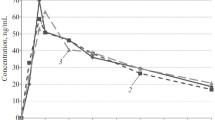Summary
The tolerance and diuretic properties of torasemide after oral or intravenous administration to healthy volunteers were studied. Six groups, each of 6 subjects, were given single rising oral doses ranging from 10 to 100 mg; 8 subjects received ascending i.v. doses on alternate days, ranging from 2.5 to 80 mg. At the highest oral doses investigated (80 mg and 100 mg) a number of volunteers complained of cramps in the knees, calves and feet. These symptoms were generally of short duration. Similar effects were not encountered during the intravenous study. There were no significant changes in ECG. Some significant drug-related changes were encountered in the within-study biochemistry and haematology assessments. Torasemide proved to be a potent diuretic following oral administration at all the doses investigated and following intravenous administration at all doses except 2.5 mg. A linear relationship existed between the urine output and the logarithm of the dose, and both sodium and chloride excretion were linearly correlated with urine volume. The rate of potassium excretion was markedly lower than that of sodium and chloride and was linearly correlated with the logarithm of the urine volume. Torasemide was well tolerated from all perspectives studied. It showed a potent diuretic property, and was equally effective by the oral and intravenous routes.
Similar content being viewed by others
References
Lesne M, Clerckx-Braun F, Duhoux P, van Ypersele de Strihoux Ch (1982) Pharmacokinetic study of torasemide in humans: An overview of its diuretic effect. Int J Clin Pharmacol Ther Toxicol 20 [8]: 382–397
Hutcheon DE, Genevieve L (1967) Diuretic and antihypertensive actions of furosemide. J Clin Pharmacol 7: 26–33
Olesen JH, Sigurd B, Steiness E, Leth A (1973) Bumetanide, a new potent diuretic. Acta Med Scand 193: 119–131
Steele TH, Oppenheimer S (1969) Factors affecting urate excretion following diuretic administration in man. Am J Med 47: 564–574
Roberts CJC, Homeida M, Roberts F (1978) Effects of piretanide, bumetanide and frusemide on electrolyte and urate excretion in normal subjects. Br J Clin Pharmacol 6: 129–133
Ambroes Y, Ronflette I, Dodion L (1984) Diuretic activity, safety and pharmacokinetics of chronic treatment with torasemide in normal subjects. Eur J Clin Pharmacol 31 [Suppl]: 1–7
O'Haug T (1976) Time course of changes in concentration of some plasma components after frusemide. Br Med J 9: 622
Murdoch WR, Auld WHR (1975) Bumetanide — acute and long term studies of a new high potency diuretic. Postgrad Med J 51: 10–14
Davies DL, Lant AF, Millard NR, Smith AJ, Ward JW, Wilson GM (1974) Renal action, therapeutic use, and pharmacokinetics of the diuretic bumetanide. Clin Pharmacol Ther 15 [2]: 141–155
Author information
Authors and Affiliations
Rights and permissions
About this article
Cite this article
Lambe, R., Kennedy, O., Kenny, M. et al. Study of the tolerance and diuretic properties of torasemide following oral or intravenous administration to healthy volunteers. Eur J Clin Pharmacol 31 (Suppl 1), 9–14 (1986). https://doi.org/10.1007/BF00541461
Received:
Accepted:
Issue Date:
DOI: https://doi.org/10.1007/BF00541461




